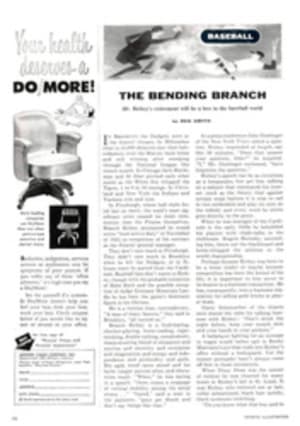
AIRBASE CLASSIC
You were reminded of an extravagant, colorful party thrown by a very popular fellow who is about to leave on a long journey—perhaps never to return. The occasion was the second annual sports car race meet at Lockbourne Air Force Base, held August 8 under the sponsorship of the Sports Car Club of America. There were about 160 drivers representing an entry of 187 cars—the largest ever received by the Sports Car Club of America in seven years of continuous racing.
The handshakes and greetings that renewed acquaintances carried a special warmth, for in everyone's mind lurked the fear that this might be the last of the big Eastern SAC (Strategic Air Command) airfield races backed by General Curtis LeMay, a true racing enthusiast. The Turner AFB event, scheduled for October 23-24 at Albany, Ga., has been canceled for economic reasons, and the wind-up of a dozen major 1954 SAC events will take place November 7 at March AFB in Riverside, Calif. No commitments have been made between the Air Force and the Sports Car Club beyond that date, and whether the program of racing will be renewed for 1955 is anybody's guess.
This uncertainty results from the efforts of Rep. Erett P. Scrivner, Republican, Kansas, to induce Congress to put an end to AFB races on the grounds that they encourage a waste of manpower and public funds. Actually, airmen's benefit funds last year netted some $500,000 from SAC races, and the majority of AFB personnel welcomed the events as a pleasant and profitable diversion. It surely can be argued that the policing of such events represents a useful exercise of manpower. The Air Force (and the Sports Car Club) position was stated eloquently by General Gates at the Chanute, Ill. AFB trophy dinner: "You don't offer your kid a dime to shine your shoes, then, when he's done the job, withhold the dime because he's used up shoe polish, electric light and a polishing cloth."
However, if Lockbourne proves to have been the last eastern airport meeting, it at least provided a brilliant finale. Most of the stars of the U.S. racing firmament were present—among them name drivers whose performances have given the sport its impetus. Briggs Cunningham, Jim Kimberly, Sherwood Johnston, Bill Lloyd, Phil Walters and former S.C.C.A. President Fred Wacker spoke for the "big boys"; Jim Simpson and Rees Makins headed the small-car contingent, which numbered drivers from almost every state and Canada.
In the vast echoing hangar reserved for competitors' cars there stood a vivid, gleaming collection of hand-built European machines worth at least half a million dollars. Among them were seven Ferraris, eight Oscas, 25 Jaguars, 18 Austin-Healeys, 23 Porsches, six Triumphs and 40 MG's, besides such makes as Singer, Lotus, Bandini, Siata, Cisitalia, Moretti, Kieft, Lester, Arnolt-Bristol, Kurtis-Kraft, Excalibur, Allard, the two big Chrysler-powered Cunninghams back from the European races of Le Mans and Rheims and a whole collection of specials, lovingly assembled by ingenious enthusiasts. Italy, Britain and Germany were, as usual, predominant among the representative makes.
By winning the Buckeye trophy—the 42-lap, 150-mile main event of the day—"Gentleman Jim" Kimberly secured beyond challenge his claim to the 1954 sports car driving championship. Kimberly, who with his brilliant red 4.5-litre Ferrari has won 16 out of 17 events this season, faced his most serious competition to date. Lined up against him were the 4.5 Ferraris of Bill Spear and Phil Walters, the Cunninghams driven by Johnston and Briggs Cunningham, some very fast Allards, notably those of Fred Warner and Lieut. Col. Reed Tilley, two outstanding C-type Jaguars driven by Ernie Erickson and Loyal Katskee, and Kimberly's former 4.1 Ferrari now owned by Ebbie Lunken. However, Spear broke his Ferrari's transmission on the starting line, and an unscheduled tangle on the fast bend at the end of the pit straight resulted in multiple collisions that changed the picture from the outset. Erickson went into a violent fishtail, causing Katskee to stand on his brakes. Kimberly, immediately behind, struck the Jaguar a glancing blow, then ricocheted off Walters' Ferrari. Lunken slipped through to hold the lead for eight laps, but Kimberly then caught and passed him. Astern, Walters spun out and soon after lost a whole lap when called into the pits to pry loose a dented fender that was touching his rear wheel. Walters, driving the race of his career, made a spectacular effort to catch Kimberly and put in an amazing lap of 2 min. 5 sec. (100 mph), but at the fall of the checkered flag he was still 1 min. 20 sec. behind the leader, who averaged 96 mph for the whole race. Kimberly and Walters both lapped the entire field, but Lunken still placed third and Katskee fourth. Altogether, a great day's racing.
PHOTO
ILLUSTRATION
OUT OF CHARACTER
THE SPEED MERCHANT
For this amateur mechanic, tinkering with automobiles was a relaxing hobby after the grinding competition in which he won fame as a tennis player. Possessing tremendous speed and power, he achieved a seldom accomplished mastery of a whole repertory of tennis strokes from killing service to powerful overhead smash. At his best under pressure, he was U.S. champion at 19, the next year added the Wimbledon title and then went on to win two thirds of nearly 400 professional matches. After quitting tennis as professional champion, he became a top-flight golfer. Now the Wilshire Country Club, Los Angeles, has as pro:
H. Ellsworth Vines

